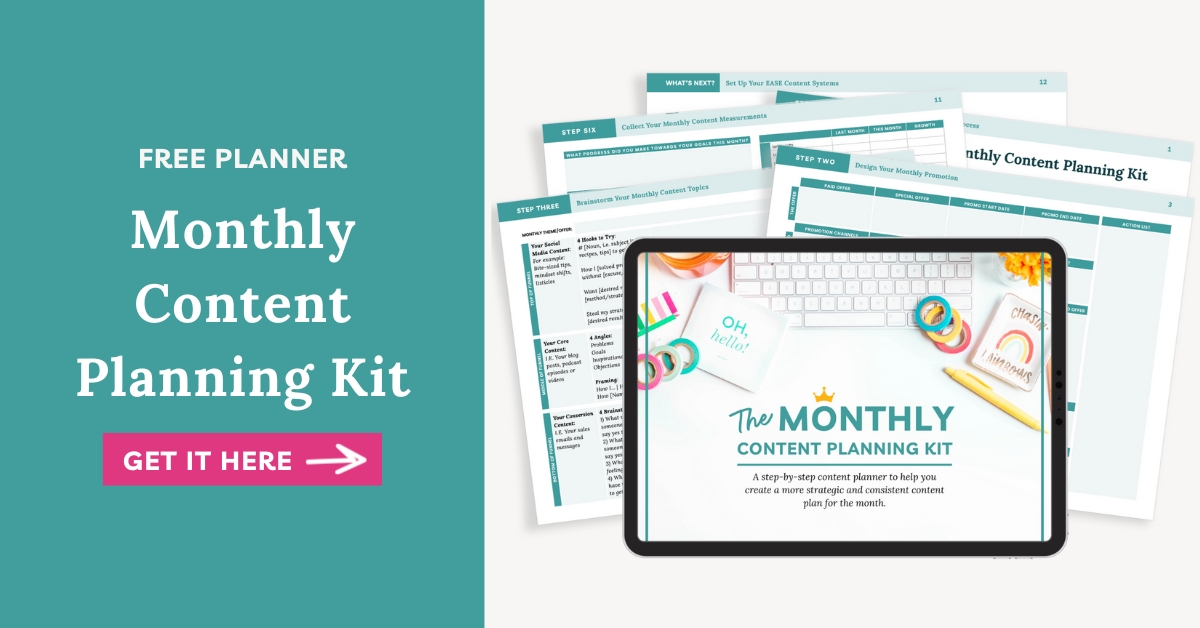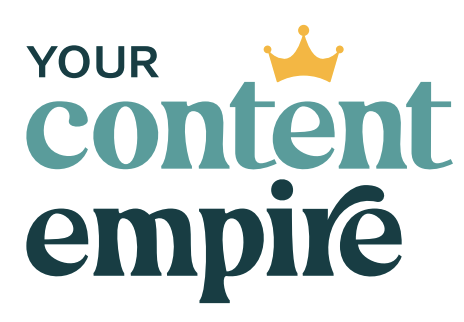Most of the problems with your current content strategy can be fixed with one tiny shift—changing how you plan your content. Specifically your monthly content planning process which we're covering in this post ↓
The issue with the typical approach is that people make a list of topics that fit their content pillars or buckets or categories and just go with whichever one of those topics tickles their fancy the most. OR you might leave things to the very last minute and just end up picking a random topic for the sake of just getting something posted ASAP.
I’ve recently made a big update to my FREE monthly content planning template. This bad boy has been downloaded more than 23, 409 times as of today and has helped business owners just like you transform their content planning and strategies. I want YOU to be the next content makeover story.
Today, I’m going to walk you through, step by step, how to use it.
So grab a copy at the link below and let’s plan your monthly content!

Prefer to watch this monthly content planning process instead?
Want to listen to the monthly content process on the go?
The #1 issue with how people plan their content—as business owners who ideally are using content as a tool to grow their businesses—is that they don’t generally plan with their offers in mind. This leads to more than just reduced sales but also lower quality leads, reduced ROI from your content efforts and increased frustration and overwhelm. AKA leaving you feeling like you’re stuck spinning on a content hamster wheel with no way to escape.
I get comments all the time from people who use the planner every month after discovering it and all about how it’s transformed their content results.
The planner has recently been remastered and reimagined to help you better keep your offers font and centre in your content without feeling like you’re being salesy or not providing value.
You can grab your free copy down below this video. In fact, pause this video, go grab your copy and I’ll wait here before we move on.
Step 1: Create Your Monthly Business Calendar
Once you download your copy of the planner (or I should say once you download your copy of the planner for the month), you’re going to want to jump over to step 1 of your monthly content planning process which is creating your monthly business calendar.
The whole point of this is to get clarity on what promotions, what events we’re planning content around. As well as, what time off and personal events we’re planning content coverage for. So you can enjoy your personal time without feeling guilty about your content.
To do this, you’ll start by numbering the days of the month you’re planning for (you can grab the Annual Content Planner if you want the dates all done for you!) but you’ll start there.
And then you’ll go through and add any other your business events, promo dates, deadlines and business travel.
Then do the same for your personal – add all personal events and time off that you need to plan your content and business around.
That’s it for step 1 (for now – although we’ll circle back here at the end to put in your core content publishing dates!)
Step 2: Design Your Monthly Promotion
Now onto step #2 of the monthly content planning process – designing your monthly promotion. This step is the big switch for a lot of business owners as we bring your content and offers into alignment and use this template to plan out the promotion for what you’re selling this month.
Not every month will include a sale so if you don’t have a promotion for a particular skip it or, better yet, use it to plan a promo for one of your free offers to give your audience a growth spurt.
Here’s what we’re going to do in this step:
Put in the paid offer, your special limited-time offer that you’ll use to encourage purchases now instead of later, the promo start date and promo end date.
Then decide on what channels you’ll use to promote your offer, your different audiences and segments of that audience that you’ll sell to (these might be customers from a prequel offer, your general email list, your instagram followers, people on the waitlist – think of this as a smaller segment within your overall audience that you’ll tailor the promotion communications for), then if relevant choose your lead generation freebie (if you’re going to do a prelaunch to generate an interest list) and whether you’ll also host a sales event like a webinar, workshop, summit or challenge as part of the lead-in to the promotion.
Finally, we’re going to start brainstorming: what are all fo the problems related to your offer? what are the goal related to your offer? what are your favourite inspirational stories and case studies related to the offer? And finally, what are the objections people might have about buying the offer … even if they’re a perfect fit for it?
Then we’re going to build out your promo weeks. As you can see, this campaign might span over a couple of months depending on big the launch or promo is, whether it includes a prelaunch and how long the actual open cart/sales phase will be.
Plan out what’s going to happening (high-level) for each week.
We also have room on the side to add any action items for the campaign too!
Step 3: Brainstorm Your Monthly Content Topics
Step #3 of the monthly content planning process is when we start brainstorming your content. We already have a lot of great ideas from the previous step in terms of topics so now we’re going to develop those further and assign them to top of funnel, middle of funnel or bottom of funnel.
Top of Funnel – refers to your content for COLD audiences. These people are not familiar with you or your work but still fit your ideal customer avatar (they just haven’t had the pleasure of meeting you yet). Because they don’t know you – we want to keep the content very focused on problems and goals. Make sure there aren’t a whole lot of inside jokes or IYKYK (if you know you know) jargon that you’ve taught your audience with your content. This is usually your social media content.
Middle of Funnel – refers to your content for WARM audiences and SLIGHTLY WARMER THAN COLD AUDIENCES. It’s your core content. Your audience reads, listens or watches it because they know you have the goods. Your cold audience follows a link from social media to check it out and suss out whether you have the goods for them (spoiler alert: we already know you do).
Bottom of Funnel – refers to your sales and conversion content for converting your warm audience into customers or repeat customers. These are the angles and topics of my sales emails and sales social media posts.
For each of these, you’re going to decide how many you need for the month and use the prompts to get you started on brainstorming your topics for top, mid and bottom of funnel content. Start by putting your theme or offer at the top so that all the content you brainstorm can fit within that common theme.
Step 4: Create Your Monthly Content Map
Okay, now let’s bring all these ideas into a cohesive monthly plan with step 4 of the monthly content planning process- creating your monthly content map.
This is one of my favourite templates in the entire kit. In fact, if you don’t have time for anything else, you can get away with just doing this one sheet as your minimum viable plan.
For each week of the month, put your blog, podcast or video topic down in the education content row of the monthly content map.
Then for each week of the month, plan how you’re going to get your content in front of new eyeballs. What’s your traffic strategy? This might be paid ads, or Pinterest, maybe a big focus on Instagram Reels.
Next, in the sell row, add plans for how you’re going to sell and promote your paid (or free) offers for the week. Maybe you’re sending emails, doing a retargeting campaign. This should align with the plan you created in step 2 for your monthly promotion.
Then, for each week of the month how do you plan on engaging with your existing audience. Maybe you’re going live on Instagram, hosting an event, sending your email newsletter. This could be your entire existing audience or even segments of your paid customers or clients too.
And then we have a row for anything else you want to plan out. I like to sometimes plan out behind-the-scenes content I want to remember to film.
You might not have every single box on here filled and that’s okay. Maybe you only release a blog post biweekly. Or a newsletter monthly.
When you’re finished, it’s a great time to revisit your business calendar from step 1 and put down any of your publishing dates there.
Step 5: Create Your Weekly Content Plans
Now let’s get to the nitty gritty of your weekly content plans with step 5 of the monthly content planning process – creating your weekly content plans. In the planner, you’ll find 5 copies of these for months that have 5 weeks. Think of these as your weekly checklist of the content that has to get out of the digital door and onto your platforms. I quite literally print these off and check them off as I go. Alternatively, you can build this step in the project management tool of your choice.
Mine is the Airtable Content Hub which you can find linked below if you want to steal my set up for yourself!
Here’s how to fill it out:
- Add your platforms to the top row
- Then for each day of the week, jot down what’s getting published on that platform.
Step 6: Collect Your Monthly Content Measurements
Last but not 100% not least is step 6 of the monthly content planning process – collecting your monthly measurements. This is for AFTER you’ve published your content as a way of measuring and reflecting on how it performed both quantitatively and qualitatively.
I like to start on the right-hand side with the numbers:
- Start by updating the metrics list to things that are important for you and your goals
- Then add the last month’s measurements
- This month’s measurements
- And the difference (whether it’s growth or regression)
- Here are my made-up numbers for this sample
Then answer the monthly journaling questions:
- What progress did you make this month towards your goals?
- What worked this month?
- What didn’t work this month?
- Where did new clients or customers come from this month?
- What ideas do you have for content, marketing or anything else for next month?
- And then you can jot down other notes too as they come up.












